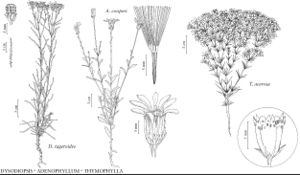Thymophylla acerosa
Sida 11: 376. 1986.
Illustrated
Basionym: Dyssodia acerosa de Candolle in A. P. de Candolle and A. L. P. P. de Candolle, Prodr. 5: 641. 1836
Revision as of 21:13, 5 November 2020 by imported>Volume Importer
Subshrubs or shrubs, green, to 25 cm, usually puberulent, sometimes glabrescent, rarely glabrous. Stems erect (branched from bases). Leaves mostly opposite; blades not lobed, linear to acerose, 10–18 mm. Peduncles 0–10 mm, puberulent or glabrous. Calyculi of 5 lance-linear bractlets, lengths 1/2+ phyllaries. Involucres campanulate to cylindric, 5–7 mm. Phyllaries ca. 13, margins of outer distinct less than 1/6 their lengths, abaxial faces puberulent or glabrous. Ray florets 7–8; corollas lemon-yellow, laminae 5–6 × 2–3 mm. Disc florets 18–25+; corollas pale yellow, 3–4 mm. Cypselae 3–3.5 mm; pappi of ca. 20 scales (each a fascicle of 3–5 bristles), 3–4 mm. 2n = 16, 24.
Phenology: Flowering through the year, mostly summer–fall.
Habitat: Calcareous outcrops, gypseous soils
Elevation: 1000–2000+ m
Distribution

Ariz., Nev., N.Mex., Tex., Utah, Mexico.
Discussion
Selected References
None.
Lower Taxa
None.
